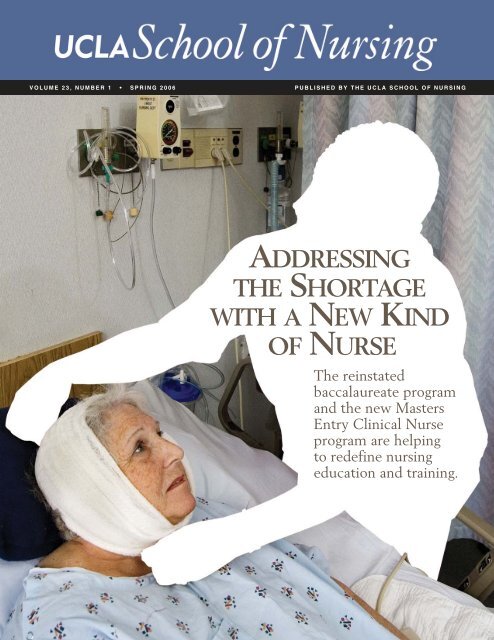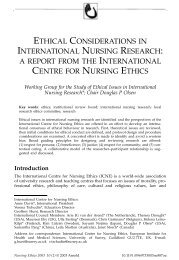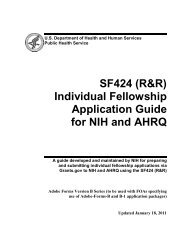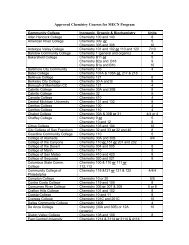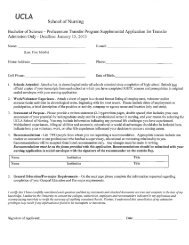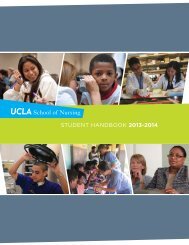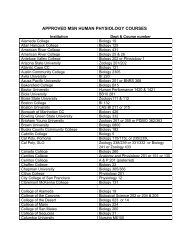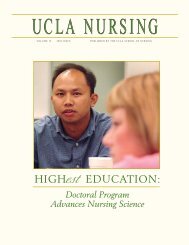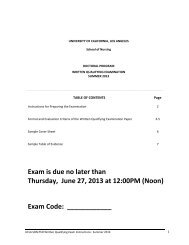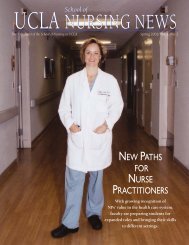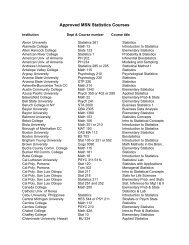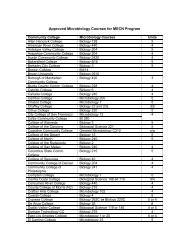Spring 2006 - UCLA School of Nursing
Spring 2006 - UCLA School of Nursing
Spring 2006 - UCLA School of Nursing
- No tags were found...
Create successful ePaper yourself
Turn your PDF publications into a flip-book with our unique Google optimized e-Paper software.
VOLUME 23, NUMBER 1 • SPRING <strong>2006</strong> PUBLISHED BY THE <strong>UCLA</strong> SCHOOL OF NURSINGADDRESSINGTHE SHORTAGEWITH A NEW KINDOF NURSEThe reinstatedbaccalaureate programand the new MastersEntry Clinical Nurseprogram are helpingto redefine nursingeducation and training.
MESSAGE FROM THE DEANPlease join us in our celebration <strong>of</strong> starting two new programs to addressthe nursing shortage in California: the Undergraduate (UG) and the MastersEntry Clinical <strong>Nursing</strong> (MECN) programs. In the past year, we have passedseveral milestones at an unbelievable pace for academia: June 2005, the UCOffice <strong>of</strong> the President contacted the school for the proposed budget; June toSeptember, the faculty wrote the curriculum; November, the UC Regentsapproved the budget; October 2005 to February <strong>2006</strong> the curriculum wasreviewed and approved by the <strong>UCLA</strong> Academic Senate; student recruitmentoccurred from February to March, <strong>2006</strong>; recruitment for eight <strong>of</strong> 22 tenuredfaculty is in process for July 1, <strong>2006</strong>; the Board <strong>of</strong> Registered <strong>Nursing</strong> approvedthe programs for state licensure in May, the same month the Commission onCollegiate <strong>Nursing</strong> Education approved the programs for national certification;and 120 students will be admitted this fall. Whew!It takes many dedicated faculty and staff to start new programs and make this happen in sucha short time. Many <strong>of</strong> them have more than gone beyond “the call <strong>of</strong> duty.” You will read in thisissue about Dr. Adey Nyamathi, associate dean <strong>of</strong> academic programs; the practice partners; andthe four “architects” <strong>of</strong> the MECN and UG curriculum: Drs. Lorraine Evangelista, MarySueHeilemann, Valda Upenieks, and Dottie Wiley. They wrote the curriculum <strong>of</strong> both programs basedon concepts from the Clinical Nurse Leader, one model at the graduate level and one model at theundergraduate level. The undergraduates can take three quarters more to achieve an MECN.There are many unsung heroes who also helped implement the UG and MECN programs.Kathy Scrivner, student affairs <strong>of</strong>ficer, helped sequence the courses, kept us on track with <strong>UCLA</strong>policies, recruited students, reviewed transcripts, admitted students…all with expertise and asmile. Assistant Dean Suzette Cardin and the entire student affairs staff did a phenomenal job inthe recruitment and admission <strong>of</strong> students. About 15 faculty and staff put in many hours readingstudent transcripts. The Recruitment Committee has been in a continuous state <strong>of</strong> reviewingdossiers and inviting faculty candidates to campus. I am privileged to be dean <strong>of</strong> such a team.Marie J. Cowan, R.N., Ph.D., F.A.A.N.SAVE THE DATE<strong>UCLA</strong> SCHOOL OF NURSING CELEBRATION DINNERSEPTEMBER 28, <strong>2006</strong><strong>UCLA</strong> – COVEL COMMONS GARDEN TERRACE
Volume 23, Number 1, <strong>Spring</strong> <strong>2006</strong>SCHOOL OF NURSINGADMINISTRATIONMARIE J. COWAN, R.N., Ph.D., F.A.A.N.DeanADELINE M. NYAMATHI, R.N., Ph.D., F.A.A.N.Associate Dean, Academic AffairsMARY A. WOO, R.N., D.N.Sc., F.A.A.N.Associate Dean, ResearchSUZETTE CARDIN, R.N., Ph.D., F.A.A.N.Assistant Dean, Student AffairsBRYANT NG, M.B.A.Assistant Dean, AdministrationDEBORAH KONIAK-GRIFFIN, Ed.D., F.A.A.N.LYNN DOERING, R.N., D.N.Sc., F.A.A.NSection ChairsJOYCE NEWMAN GIGER, Ed.D., A.P.R.N.,B.C., F.A.A.N.Faculty ChairRENE DENNISDirector <strong>of</strong> Development4NEW PROGRAMSADDRESS NURSING NEEDSUndergraduates, Graduates from Other FieldsWill Be Prepared to Assume Clinical Leadership Positions8HELPING TO REDEFINETHE WAY NURSES ARE EDUCATEDAND TRAINEDFaculty Team Designs Forward-Looking CurriculumStressing Population-Based Approach, Clinical LeadershipConcepts: “Both a Bird’s Eye View and a Bedside View”8DAN GORDONEditor and WriterMARTHA WIDMANNArt Director16ALUMNI REJOICE ATRETURN OF PROGRAMFor <strong>School</strong>’s Earliest Graduates, <strong>UCLA</strong> BaccalaureateDegree Holds Special Meaning – it Launched TheirSuccessful <strong>Nursing</strong> Careers18DEVELOPMENT16Photography:Reed Hutchinson (cover, p. 3: New Programs,pp. 4-15); Courtesy <strong>of</strong> the <strong>School</strong> <strong>of</strong> <strong>Nursing</strong>(p. 2; p. 3: Rene Dennis; p. 17: Moidel; p. 19);Courtesy <strong>of</strong> Judy Benson (p. 16); Courtesy <strong>of</strong> ArleneHealy Rocchio (pp. 3, 17); Courtesy <strong>of</strong> Mirja Bishop(p. 17); Courtesy <strong>of</strong> Sheryl Caverly (p. 17); Courtesy<strong>of</strong> Rose Marie Nesbit (p.17).18<strong>UCLA</strong> <strong>School</strong> <strong>of</strong> <strong>Nursing</strong> is published by the<strong>UCLA</strong> <strong>School</strong> <strong>of</strong> <strong>Nursing</strong> for the alumni, faculty,students, staff and friends <strong>of</strong> the school.For information about academic programs andstudent affairs, call (310) 825-7181, or e-mail:sonsaff@sonnet.ucla.eduDean’s Office: (310) 825-9621Copyright <strong>2006</strong> by The Regents <strong>of</strong> the University<strong>of</strong> California. Permission to reprint any portion <strong>of</strong><strong>UCLA</strong> <strong>School</strong> <strong>of</strong> <strong>Nursing</strong> must be obtained fromthe editor. Contact Editor, <strong>UCLA</strong> <strong>School</strong> <strong>of</strong> <strong>Nursing</strong>,Box 951702, Los Angeles, CA 90095-1702.WWW.NURSING.<strong>UCLA</strong>.EDU
New ProgramsAddress <strong>Nursing</strong> NeedsUndergraduates, Graduates from Other Fields WillBe Prepared to Assume Clinical Leadership Positions“The complexity <strong>of</strong> hospital nursing requires a well-educated The shortage <strong>of</strong> bedside nurses that has plaguednurse to help manage the care <strong>of</strong> very sick patients. Our programs U.S. hospitals for nearly a decade isn’t for the reasonsmost people think, at least in California. Plentywill help to attract bright and talented individuals to the pr<strong>of</strong>ession,and will prepare them to make a difference in this challeng-to become nurses; the problem has been finding<strong>of</strong> people in the state hardest hit by the crisis wanting environment.”— Dr. Marie Cowan, Dean places to educate these qualified candidates.With that in mind, the UC Board <strong>of</strong> Regentsvoted in November to allocate $5.2 million to reinstate the <strong>UCLA</strong> <strong>School</strong> <strong>of</strong> <strong>Nursing</strong>’sbaccalaureate program – which had been active from 1949 until 1996 beforebeing suspended because <strong>of</strong> budget constraints – and start a new Masters EntryClinical Nurse (MECN) degree program at the school. The MECN program willtake non-nurses who have already completed undergraduate studies in other fieldsand prepare them for nursing leadership roles in hospitals and other health-care deliverysettings.Thus, beginning in the fall, the school will <strong>of</strong>fer the UC system’s only undergraduatenursing degree program, along with an innovative graduate program thatwill prepare individuals without previous nursing experience for eventual nursingleadership positions in hospitals and other settings. The new programs will morethan double the number <strong>of</strong> nursing students enrolled at <strong>UCLA</strong> by 2010, from thecurrent 300 to 624.These students won’t have to look far to find jobs once they graduate. The“help wanted” sign is up for more than 100,000 nursing positions across the country,and the demand for nurses is particularly dire in California, which ranks 49th out <strong>of</strong>the 50 states in nurse-to-population ratio. Given the state’s rapid growth and agingpopulation, an additional 43,000 nurses will be needed by 2010 just to maintain this4 <strong>UCLA</strong> NURSING
<strong>UCLA</strong> NURSING 5
low ratio, according to a study by UC San Francisco.Complicating matters for California hospitalsis a new state law mandating that wards carrya minimum <strong>of</strong> one nurse for every five patients.Lack <strong>of</strong> interest in nursing is not the problem.“The work environment and salary levelshave improved to the point that this is now seenas a tremendously attractive field,” says HeidiCrooks, <strong>UCLA</strong> Medical Center’s senior associatedirector <strong>of</strong> operations and patient care services.“As a result, in California we have thousands <strong>of</strong>superbly qualified individuals who are interested,but can’t get in.”That’s because <strong>of</strong> an educational bottleneckthat has sent would-be nurses to other states, orother pr<strong>of</strong>essions. The two pathways to becominga registered nurse are the two-year associatedegreeprogram <strong>of</strong>fered by community collegesand the four-year baccalaureate degree <strong>of</strong>fered,to Dr. Marie Cowan, dean <strong>of</strong> the <strong>UCLA</strong> <strong>School</strong><strong>of</strong> <strong>Nursing</strong>. National nursing organizations haverecommended that the four-year baccalaureatedegree be required for entry into pr<strong>of</strong>essionalnursing.“California has a shortage <strong>of</strong> nurses relatedto both quantity and quality – we don’t haveenough, and we don’t have enough with baccalaureateor higher degrees,” says Cowan. Thereinstated baccalaureate program and the newMECN program will address both shortages,Cowan adds, as will expansion <strong>of</strong> the school’s existingA.D.-B.S.-M.S.N. “bridge” program that<strong>of</strong>fers associate-degree nurses the opportunity toearn a bachelor’s and master’s degree in threeyears.The master plan for education in Californiacalls for the upper 12.5 percentile <strong>of</strong> high schoolgraduates to be eligible for the UC system. With“Patients in hospitals are more complex today than they ever were,making it very important that we raise the bar for nursingeducation in California. We’re very excited that our new programswill be addressing concerns about quality as well as quantity.”— Dr. Adey Nyamathi, Associate Dean for Academic Affairsuntil now, through the California State Universitysystem and private universities. All <strong>of</strong> theseprograms are fully enrolled, and many have admissionwaiting lists as long as three years. Educatinghealth pr<strong>of</strong>essionals is expensive – and theshortage <strong>of</strong> nursing faculty is as acute as theshortage <strong>of</strong> nurses working at the bedside.The undersupply <strong>of</strong> baccalaureate nursingprograms in California has given the state a muchhigher proportion <strong>of</strong> registered nurses who aregraduates <strong>of</strong> two-year associate-degree programs(80%) than the national average (30%), accordingthe UC system lacking an undergraduate nursingprogram in recent years, that meant that thestate’s brightest college students were discouragedfrom going into the pr<strong>of</strong>ession. “We havealways felt that the top-caliber students who areadmitted into the UC system should be giventhe option <strong>of</strong> going into nursing as undergraduates,setting them on the course for graduatenursing studies,” says Dr. Mary Ann Lewis, pr<strong>of</strong>essorand chair <strong>of</strong> the school’s UndergraduateProgram Committee.“The <strong>UCLA</strong> <strong>School</strong> <strong>of</strong> <strong>Nursing</strong>’s decision toadd these important new programs will help addressthe severe shortage <strong>of</strong> hospital nurses inthe state,” says Dr. Gerald S. Levey, vice chancellor<strong>of</strong> <strong>UCLA</strong> Medical Sciences and dean <strong>of</strong>the David Geffen <strong>School</strong> <strong>of</strong> Medicine at <strong>UCLA</strong>.“Knowledgeable pr<strong>of</strong>essional nurses can lowerthe length <strong>of</strong> hospital stays, reduce costs, preventmedical errors, and enhance patient satisfaction,quality <strong>of</strong> care and health-related quality <strong>of</strong> life.”6 <strong>UCLA</strong> NURSING
“Patients in hospitals are more complex todaythan they ever were, making it very important thatwe raise the bar for nursing education in California,”adds Dr. Adey Nyamathi, associate dean foracademic affairs at the school. “We’re very excitedthat our new programs will be addressing concernsabout quality as well as quantity.”In addition to becoming leaders in the acutecare setting, graduates <strong>of</strong> these programs willhelp to address an aspect <strong>of</strong> the nursing shortagethat is at least as severe as the shortage in hospitalsettings: the dearth <strong>of</strong> nursing faculty acrossthe country, according to Lewis. “In the past,more than half <strong>of</strong> our undergraduate studentshave gone on to graduate school,” she notes.Students in both the baccalaureate andMECN programs will be given curricula thatstress concepts important to clinical nursing leadership,including knowledge <strong>of</strong> organizationalsystems, case management, and population-basedpatient care. Concurrent with the classroomlearning, they will spend 40 hours a week in clinicalrotations that will find them paired with nursingpr<strong>of</strong>essionals caring for patients at <strong>UCLA</strong>Medical Center, Santa Monica-<strong>UCLA</strong> MedicalCenter, Cedars-Sinai Medical Center and SaintJohn’s Health Center. Students in the baccalaureateprogram will also be able to minor in anothersubject, to expand their knowledge base.“The complexity <strong>of</strong> hospital nursing requiresa well-educated nurse to help manage thecare <strong>of</strong> very sick patients,” Cowan says. “Ourprograms will help to attract bright and talentedindividuals to the pr<strong>of</strong>ession, and will preparethem to make a difference in this challenging environment.”Despite the short notice, both the MECNand undergraduate programs received far moreapplications than there were enrollment slots, accordingto Dr. Suzette Cardin, the school’s assistantdean for student affairs. “We were extremelypleased with the quality <strong>of</strong> the applicantpool,” Cardin says. “The process for both programswas extremely competitive.”Those admitted to the undergraduate programmeet the same high qualifications as other<strong>UCLA</strong> freshmen. For Kai Craig, a stellar studentat Fairfax High who will begin the school’s baccalaureateprogram in the fall, the resumption <strong>of</strong>the program couldn’t have come at a better time.“I’ve known I wanted to go into nursing forawhile,” she says. “But until <strong>UCLA</strong> reopened its“We have always felt that the top-caliber students who areadmitted into the UC system should be given the option <strong>of</strong> goinginto nursing as undergraduates, setting them on the course forgraduate nursing studies.”— Dr. Mary Ann Lewis, Chair, Undergraduate Program Committeeprogram I thought I would have to go out <strong>of</strong>state. Staying close to home was my first choice.”Cardin notes that the new MECN studentswill be a diverse group coming from many differentpr<strong>of</strong>essions and bringing a wide variety <strong>of</strong> lifeexperiences. That appeals greatly to MicheleMaines, one <strong>of</strong> the students who will start theMECN program in the fall. “It makes for a muchmore well-rounded learning experience whenyou have people from diverse backgrounds,” saysMaines, 33, who got her undergraduate degreefrom <strong>UCLA</strong> in psychobiology in 1996 and is currentlyworking as a research assistant in <strong>UCLA</strong>’sDepartment <strong>of</strong> Neurology.“<strong>Nursing</strong> is such a great pr<strong>of</strong>ession with somany opportunities right now,” adds Maines,who wants to become a gerontology nurse. “TheMECN program is perfect – it enables me tobuild upon the experience I have and take myeducation and career to the next level.”<strong>UCLA</strong> NURSING 7
Helping to Redefinethe Way Nurses AreEducated and TrainedFaculty Team Designs Forward-Looking Curriculum StressingPopulation-Based Approach, Clinical Leadership Concepts:“Both a Bird’s Eye View and a Bedside View”“They’re going to be generalists at the bedside who have a strong In developing curricula for the new Masters EntryClinical Nurse (MECN) and reinstated genericknowledge base about health care delivery systems. We wantBachelor <strong>of</strong> Science programs, the <strong>UCLA</strong> <strong>School</strong>these nurses to think beyond just ‘me and the patient.’ ” <strong>of</strong> <strong>Nursing</strong> sought to address the needs <strong>of</strong> the— Valda Upenieks state, which provided funding for the programs asa response to the severe nursing shortage.But beyond educating nurses who will be prepared to work at the bedside, wherethe shortage is particularly great, the two programs – along with the expanded A.D.-B.S.-M.S.N. “bridge” program – will be setting a new standard in the way they preparegraduates, say the faculty and administrators who were involved in their design.When it appeared funding might become available to start the MECN, a newgraduate degree program for non-nurses who had earned a baccalaureate in anotherfield, Dean Marie Cowan assembled a team <strong>of</strong> faculty members to work with AssociateDean for Academic Affairs Adey Nyamathi in developing a curriculum for the proposeddegree. They received input from nurse leaders in the community, including theschool’s practice partners at <strong>UCLA</strong> Medical Center, Santa Monica-<strong>UCLA</strong> MedicalCenter, Saint Johns Health Center and Cedars-Sinai Medical Center.The group proved to be dynamic, with each member bringing disparate backgroundsand expertise to the process. The team’s core faculty members included Dr.Valda Upenieks, a former hospital director whose research has looked at how leadershipand organizational structure affect bedside care; Dr. Lorraine Evangelista, a clinical nursespecialist and tertiary care expert who has developed interventions for advanced heartfailure patients; Dr. Dorothy Wiley, an epidemiologist whose expertise is in primary, secondary,and tertiary approaches to prevention; and Dr. MarySue Heilemann, a publichealth nurse whose focus includes bringing population-based approaches to the hospitalsetting.8 <strong>UCLA</strong> NURSING
The MECN program is based on a nationalmovement inspired by the American Association<strong>of</strong> Colleges <strong>of</strong> <strong>Nursing</strong> (AACN) to develop ClinicalNurse Leader programs. The AACN’s idea isto equip the nurse to think not only about individualpatient care, but also about the bigger pictureon the unit, in the facility and in the community.In short, Heilemann explains, the AACN’sclinical nurse leaders would have both a bird’s eyeview and a bedside view. “AACN was brilliant inidentifying that what we really need, more thanspecialists, are expert generalists,” she says. “Weneed nurses at the bedside who can see the bigpicture while being involved in the intricate dailyactivities <strong>of</strong> caring for patients. This is very differentfrom taking snap clinicians who want to specializeas nurse practitioners, and teaching themcommunity health and population-based nursing.”The curriculum committee attended conferenceson the Clinical Nurse Leader concept,meeting with nurse leaders from across the countryto talk about the new vision. Based on thoseand other discussions, the faculty began to devisea curriculum with the goal <strong>of</strong> educating mastersentry nurses who would take a trifocal approach –providing patient care while simultaneously payingattention to the unit and the larger systems,both hospital and community. These nurses willenter clinical practice at the master level, wellequipped to advance to leadership positions.“These students will not pursue the sametrack as nurse practitioners or clinical nurse specialists,”says Upenieks. “They’re going to be generalistsat the bedside who have a strong knowledgebase about health care delivery systems.”“Our graduates will be critical thinkers,” saysEvangelista. “Beyond knowing how to treat patients,they will be focusing on health promotionand illness prevention, and they will think interms <strong>of</strong> groups <strong>of</strong> patients, the hospital, and thecommunity.”With the program being designed to preparenurses who will be able to make an impact withina short period <strong>of</strong> time, Evangelista stresses thatthe curriculum will be rigorous and extremelychallenging.“We want these nurses to think beyond just‘me and the patient,’ ” says Upenieks, noting thatmany <strong>of</strong> the budget and financial concepts thatshe teaches to students in the school’s <strong>Nursing</strong>Administration program will be included in theMECN curriculum, as well as skills ranging fromDR. VALDA UPENIEKS(SECOND FROM RIGHT),A FORMER HOSPITALDIRECTOR WHOSERESEARCH HAS LOOKEDAT HOW LEADERSHIP ANDORGANIZATIONAL STRUC-TURE AFFECT BEDSIDECARE, WAS AMONG THEFACULTY WHO DEVELOPEDTHE NEW CURRICULUM.<strong>UCLA</strong> NURSING 9
Heidi CrooksSenior Associate Director <strong>of</strong> Operations and Patient Care Services“ degree at the school, they always talk about the excellence <strong>of</strong> the education and the”<strong>UCLA</strong> Medical CenterFor every slot in a baccalaureate-degree program in California, we have threehighly qualified candidates who could help fill the nursing need in California, butcan’t get in. That’s one reason the reopening <strong>of</strong> the <strong>UCLA</strong> baccalaureate programis exciting. Another is that the quality <strong>of</strong> the <strong>School</strong> <strong>of</strong> <strong>Nursing</strong> is outstanding.Whenever we have nurses working for us while they’re getting their graduateschool’s faculty. We are also excited about the MECN program, because from ourexperience with other universities that have similar programs, the students it willattract tend to have superb critical thinking skills and a high level <strong>of</strong> maturity.10 <strong>UCLA</strong> NURSING
DR. LORRAINE EVANGE-LISTA, A CLINICAL NURSESPECIALIST AND TERTIARYCARE EXPERT WHO HASDEVELOPED INTERVENTIONSFOR ADVANCED HEARTFAILURE PATIENTS,STRESSES THAT THE NEWCURRICULUM WILL BE EX-TREMELY CHALLENGING.given the diversity <strong>of</strong> California’s patient population.The curriculum will include courses such asinformatics, health care organization and systems,systems at the unit level, health care policy, andpopulation-based quality practice, as well as astrong social justice component. “These coursesare now being required for the MECN students atthe same time that they’re learning to becomenurses,” Nyamathi says. “That dual focus is whatmakes this program particularly innovative.”When it became apparent that funding mightalso become available to reopen the baccalaureateprogram, many <strong>of</strong> the same faculty and practicepartners who worked on the MECN curriculumbegan to develop a program for undergraduatenursing majors that would adhere to principlesthat formed the basis for the MECN. “We’re reopeningthe baccalaureate program with very sighowto interact effectively with other health disciplinesand delegate appropriately to providing patient-centeredcare. “Currently, hospitals are facingnumerous throughput issues,” she explains.“In the past year, the occupancy rate for most hospitalsaround the country has dramatically increasedto 95 percent. These demands are pushinghospitals to operate at close to maximum, resultingin lack <strong>of</strong> resources, including staffing andequipment. With not enough beds or nurses, weneed to teach nurses ‘systems-thinking’ and providethem with the tools for getting patientsthrough the system in the best way possible.”The ability to treat very sick patients in thecomplex hospital system environment while focusingon cost-effectiveness, quality <strong>of</strong> care, andsound clinical decision-making will be central tothe knowledge base <strong>of</strong> the MECN graduates, saysNyamathi. Research courses will prepare them tolook at the larger environment as they provide patientcare – assessing the literature to ensure thatclinical decisions are based on the best evidence.As with the school’s other programs, cultural competencywill be a strong component, particularly“These graduates will be critical thinkers. Beyond knowing how to treatpatients, they will be focusing on health promotion and illness prevention,and they will think in terms <strong>of</strong> groups <strong>of</strong> patients, the hospital, and thecommunity.” — Lorraine Evangelista<strong>UCLA</strong> NURSING 11
DR. DOROTHY WILEY,AN EPIDEMIOLOGISTWHOSE EXPERTISE IS INPOPULATION-BASEDAPPROACHES TO CARE,BELIEVES NURSES NEEDTO THINK ABOUT BROADISSUES OF COMMUNITYHEALTH DURING EVERYPATIENT ENCOUNTER.“These programs will be preparing nurses who know how to operate ina complex environment from a social and technological perspective. We willbe educating people on the cutting edge <strong>of</strong> issues that deal with all <strong>of</strong> thedimensions <strong>of</strong> health care, whether it’s biology, sociology, or psychology.”— Dorothy Wiley12 <strong>UCLA</strong> NURSINGnificant changes,” says Nyamathi. “Many <strong>of</strong> theprogram’s graduates will be working at the bedside,but we want them to do so with a population-basedperspective.”Dr. Mary Ann Lewis, chair <strong>of</strong> the UndergraduateProgram Committee, explains that unlike theschool’s previous baccalaureate program, studentsthis time will be able to choose a minor in additionto their nursing major. “We want to groom themfor leadership roles,” she says. “Consistent withour mission as a research university, we hopemany <strong>of</strong> them go on to become not only practicingnurses, but also nurse scientists and educators.”Both the MECN and the baccalaureate programsset students on a path that would easily enablethem to continue to work toward a doctorate,Lewis says.Both the baccalaureate and the MECN programsreflect a new vision for how nursing educationcan be implemented. “I think we’re unique inour commitment to a focus that goes beyond themanagement <strong>of</strong> individuals or units,” says Heilemann.She notes that the basis for the MECN programis a public health nursing practice model firstused in Los Angeles County and later adopted bythe California Department <strong>of</strong> Health Services.Heilemann and Wiley, who have taught the modelto public health nurses, felt that it could be effectivelyadapted for nurses in the hospital setting.Both the MECN and baccalaureate students willtake a public health nursing course, in which theywill gain experience with population-based communityhealth.“Nurses can work with the ill or infirmed andhelp them get well while also maximizing theprobability that the population will stay healthy,”explains Wiley. “We can’t be so focused on individualsthat we lose track <strong>of</strong> what needs to bedone for the larger group.” When a woman entersa hospital with gallbladder disease, for example,maximizing the population’s health would mean
Mary Ellen BlakleyVice President, Patient Care Services“”Saint John’s Health CenterThe new nursing programs at <strong>UCLA</strong> are wonderful! We have had the opportunityto partner with the <strong>UCLA</strong> <strong>School</strong> <strong>of</strong> <strong>Nursing</strong> faculty to shape the curriculum,and we know for a fact that the graduates from <strong>UCLA</strong> will be competent, confident,and ready to hit the ground running. The nursing shortage is not going away,and in fact, will become greater as the aging baby boomers begin to need morehealth care and our “boomer” nurses retire. We currently have great nursingschools in Southern California, but they cannot keep up with the demand for newnurses. <strong>UCLA</strong>’s programs will assist greatly in alleviating the acuteness <strong>of</strong> theshortage. We have always wished for a local solution. Now we have one, rightin our own backyard!<strong>UCLA</strong> NURSING 13
Linda Burnes BoltonVice President and Chief <strong>Nursing</strong> Officer“Cedars-Sinai Medical CenterThe need for baccalaureate and advanced practice nurses to achieve patientsafety and quality goals has increased dramatically over the last 10 years. It is theincreased demand for patient care that influences the number <strong>of</strong> nurses requiredby health care organizations to provide safe, reliable, patient-centered, lean andefficient care. The reinstatement <strong>of</strong> the <strong>UCLA</strong> <strong>School</strong> <strong>of</strong> <strong>Nursing</strong>’s baccalaureateprogram is critical and will contribute to our goal <strong>of</strong> improving the capacity <strong>of</strong>health care organizations to meet the public’s demand for care. Cedars-SinaiMedical Center is proud to be a part <strong>of</strong> the <strong>School</strong> <strong>of</strong> <strong>Nursing</strong> clinical sites and tosupport the expansion <strong>of</strong> the vital education, clinical and research initiatives providedby the school. Dr. Marie Cowan is a visionary leader with an extraordinary”faculty <strong>of</strong> dedicated pr<strong>of</strong>essionals committed to working with students, staff, healthcare and community organizations and the alumni to ensure access to the bestqualifiednursing staff in the country.REVISED VERSION OF THEPUBLIC HEALTH NURSINGPRACTICE MODEL FIRSTPUBLISHED BY KATHLEENSMITH AND NOEL BAZINI-BARAKAT IN THE JOURNALPUBLIC HEALTH NURSING,2003, VOL. 20, PP. 42-48.THE <strong>UCLA</strong> SCHOOL OFNURSING HAS ADAPTEDTHIS MODEL FOR USE INTHE MECN AND UNDER-GRADUATE PROGRAMS.14 <strong>UCLA</strong> NURSING
DR. MARYSUE HEILEMANN,A PUBLIC HEALTH NURSEWHOSE FOCUS INCLUDESBRINGING POPULATION-BASED APPROACHES TOTHE HOSPITAL SETTING,WAS ONE OF FOUR JUNIORFACULTY MEMBERS WHOHELPED TO DEVELOPTHE NEW CURRICULUM.not only treating the disease, but also finding outwhen the woman was last screened for cervicaland breast cancer and whether her family risk factorsindicate any other concerns that need to befollowed up on, Wiley notes.For nurses to be looking beyond the immediatehealth needs <strong>of</strong> the patient in front <strong>of</strong> them requiresthat they understand a wide range <strong>of</strong> issues,Wiley adds, including all aspects <strong>of</strong> primary,secondary and tertiary prevention. “We havestructured our program so that there is a developmental,integrated approach with wellness as anemphasis rather than a footnote,” Wiley says.In California, more than in other states, thenursing shortage is not just one <strong>of</strong> quantity. Onlyone in five nurses in the state has a baccalaureateor graduate degree. “Our programs are going toexpand the pr<strong>of</strong>essionalism <strong>of</strong> nursing,” says Upenieks.“We believe our graduates will enhance thelevel <strong>of</strong> nursing as a pr<strong>of</strong>ession not only at thebedside but also within the health care deliverysystem. We need to heighten awareness <strong>of</strong> theworth nursing brings to the organization and <strong>of</strong>“We need nurses at the bedside who can see the big picture whilebeing involved in the intricate daily activities <strong>of</strong> caring for patients.I think we’re unique in our commitment to a focus that goes beyondthe management <strong>of</strong> individuals or units.” — MarySue Heilemannthe fact that nurses are the most crucial asset inproviding excellence in patient care, and thesenurses are going to help to do that.”“My hope is that these will be the best nurseswho have ever hit our streets – and I believe theywill be,” says Wiley. “These programs will bepreparing nurses who know how to operate in acomplex environment from a social and technologicalperspective. We will be educating peopleon the cutting edge <strong>of</strong> issues that deal with all <strong>of</strong>the dimensions <strong>of</strong> health care, whether it’s biology,sociology, or psychology.”“The nursing shortage is not just in California;it’s national and international,” concludesHeilemann. “We believe that if we can improvehow nurses are trained here, it can have a positiveeffect across the country and around the world.”<strong>UCLA</strong> NURSING 15
Alumni Rejoice atReturn <strong>of</strong> ProgramFor <strong>School</strong>’s Earliest Graduates, <strong>UCLA</strong> BaccalaureateDegree Holds Special Meaning – it Launched TheirSuccessful <strong>Nursing</strong> CareersThe announcement that the <strong>UCLA</strong> <strong>School</strong> <strong>of</strong> <strong>Nursing</strong>had received funding to reinstate its baccalaureateprogram after a 10-year absence was greeted withenthusiasm from many quarters, but one would behard-pressed to find a group more thrilled by thenews than the program’s earliest graduates.“It was a great sorrow for all <strong>of</strong> us to see it disappearin the first place,” says Judy Benson, who graduatedfrom the school’s baccalaureate program in 1960.“We’ve all just been champing at the bit, hoping itwould one day reopen, and we’re very happy that it’s starting again.”Beyond the sentimental value <strong>of</strong> seeing the reinstatement <strong>of</strong> the program thatprepared her for her nursing career, Benson is pleased for the positive impact futuregraduates will have in the community. “There is such a great need not onlyfor registered nurses, but for nurses who can go on to assume leadership roles,which is what these graduates will be doing,” she says.One <strong>of</strong> Benson’s classmates, Arlene Healey Rocchio, says she didn’t immediatelyappreciate the extent to which the <strong>UCLA</strong> <strong>School</strong> <strong>of</strong> <strong>Nursing</strong> baccalaureateprogram prepared her for pr<strong>of</strong>essional success. “I went on to work with mostlydiploma nurses, and I saw that they were not taught to question things in the waywe were,” she says. “It was an eye-opening experience.”“We were taught to think about what we were doing, and to question decisionsthat were made by other health care providers, including doctors,” agreesMirja Bishop, B.S. ’60, who says that the ability to think critically served her extremelywell over the course <strong>of</strong> a 30-year career as a public health nurse, much <strong>of</strong> itspent in tuberculosis control.“It’s hard to put into words the skills you get when you’re in a university setting,”Bishop says. “I didn’t realize it at the time, but later on it served me in mywork situations over and over again.”“This will help to draw high-caliber nurses to the pr<strong>of</strong>ession, because they willbe getting a <strong>UCLA</strong> education,” says Sheryl Caverly, who graduated from the bac-16 <strong>UCLA</strong> NURSING
calaureate program in 1957 and received her master’s degree from the school in1958. Caverly, who went on to work as a high school nurse, explains that she chose<strong>UCLA</strong> not just because <strong>of</strong> the nursing program but because <strong>of</strong> the excellent generaleducation she knew she would receive.Rose Marie Nesbit, B.S. ’57, says the high-quality education her class receivedwas reflected in the remarkable breadth <strong>of</strong> positions her classmates went on to attain.“What I gained from the undergraduate program at <strong>UCLA</strong> has been invaluableto me in so many respects,” she says.Nesbit believes the reopening <strong>of</strong> the program will benefit not only futurenursing students, but also the larger community. “As an outstanding program locatedwithin a major research center, the <strong>UCLA</strong> <strong>School</strong> <strong>of</strong> <strong>Nursing</strong> provides excellententrance into the nursing pr<strong>of</strong>ession,” she says. “These graduates end up influencingthe nurses and other health care pr<strong>of</strong>essionals with whom they come incontact and elevate nursing care everywhere they go.”(L. TO R.): FROM THE BACCALAUREATE CLASSOF 1960: JUDY BENSON, ARLENE HEALY ROCCHIO,MIRJA BISHOP; FROM THE BACCALAUREATECLASS OF 1957: SHERYL CAVERLY, ROSE MARIENESBITIN MEMORIAM:HARRIET MOIDELPr<strong>of</strong>essor Emeritus Harriet Moidel passed away onApril 11, <strong>2006</strong> from pneumonia. Harriet CostonMoidel was one <strong>of</strong> the founding faculty <strong>of</strong> the school.She served first as assistant dean from 1970-1971, andfrom 1976-1977 shared the title <strong>of</strong> associate dean withDonna Vredevoe. Moidel retired in 1979 after 28 years<strong>of</strong> service to the school. The pr<strong>of</strong>essional collaborationbetween Moidel and Dean Lulu Wolf Hassenplug extendedinto a lifelong friendship. Moidel was marriedto a lawyer and did not have children.In lieu <strong>of</strong> flowers, the family asks that she be rememberedwith gifts to the Harriet Coston Moidel Fundsent to Dean Marie Cowan, <strong>UCLA</strong> <strong>School</strong> <strong>of</strong> <strong>Nursing</strong>,P.O. Box 951702, Los Angeles, CA 90095.<strong>UCLA</strong> NURSING 17
THE CHIRONIAN SOCIETYIn our last issue, the headline read: “The Chironian Society – ComingSoon!” Well, it’s here! We are gearing up to welcome our new undergraduateclass this fall, and The Chironian Society will play a major role. The mainfocus <strong>of</strong> The Chironian Society is to enhance the student experience andprovide scholarships. The school will look to the society as the alumnifundraising arm, with annual renewal memberships to allow us to forecastour ability to distribute scholarships each year.Membership in The Chironian Society is available at the followingannual levels:Chironian Honor Roll $1,000Chironian Patron Member $ 500Chironian Regular Member $ 200Pledges are accepted for annual memberships (to be realized within the fiscalyear).As a Chironian, you will receive an acknowledgement <strong>of</strong> your membershipand invitations to <strong>UCLA</strong> <strong>School</strong> <strong>of</strong> <strong>Nursing</strong> events. You will also be invitedto participate in various volunteering opportunities and, at the appropriategiving level, be listed in the <strong>UCLA</strong> <strong>School</strong> <strong>of</strong> <strong>Nursing</strong> Honor Roll.As a member <strong>of</strong> The Chironian Society, you will be investing not only inthe school, but also to the future <strong>of</strong> nursing pr<strong>of</strong>essionals for years to come.We invite your membership. You may contact our new DevelopmentOfficer, Rene Dennis, at (310) 206-3662 and/or visit our Web site:www.nursing.ucla.edu.Membership contributions to The Chironian Society are different and separatefrom the annual fund.DID YOU KNOW?- Named- You- Ifstudent scholarships and endowments can be established based onfunding amounts. Endowed scholarships can be established for a minimum<strong>of</strong> $50,000. Endowed graduate fellowships can be established for a minimum<strong>of</strong> $100,000. The <strong>UCLA</strong> <strong>School</strong> <strong>of</strong> <strong>Nursing</strong> appreciates contributions in anyamount.can make a gift to the <strong>UCLA</strong> <strong>School</strong> <strong>of</strong> <strong>Nursing</strong> that will provide incomefor your lifetime as well as an immediate income tax charitable deduction.you are 75 years <strong>of</strong> age, you can establish a charitable gift annuity that hasa 7.1% payout rate that will continue for your lifetime. The older you are thehigher the payout rate.- You can make a gift <strong>of</strong> your home, receive an immediate income tax charitablededuction and continue to live there for your lifetime.- Bequests are a significant source <strong>of</strong> support for the <strong>School</strong> <strong>of</strong> <strong>Nursing</strong>.GIFT ANNUITYPAYMENT RATES(Single Life)Please callfor currentbenefits andrates fortwo persons.AGE6570758085RATE6.0 %6.5 %7.1 %8.0 %9.5 %RENE DENNISAPPOINTEDDIRECTOR OFDEVELOPMENTDean Marie Cowan has hired a new development<strong>of</strong>ficer, Rene Dennis. While this is a newadministrative position for Dennis, she is notreally new to <strong>UCLA</strong>, nor is she unfamiliar withthe <strong>School</strong> <strong>of</strong> <strong>Nursing</strong>. Dennis has served on theChancellor’s Staff for nearly 25 years, and hasbeen the administrator <strong>of</strong> executive searches forthe chancellor for 22 <strong>of</strong> those years. In that role,she was the coordinator for the administrativesearches that recruited former <strong>School</strong> <strong>of</strong> <strong>Nursing</strong>dean Ada Lindsey and current dean Cowan.Many members <strong>of</strong> the school’s faculty knewDennis already, and she says she has felt welcomedto the school since her arrival February 1.Dennis began working at <strong>UCLA</strong> in 1980,spending one year in the Clinical Social Workdepartment. In 1981, after the birth <strong>of</strong> her son,she transferred to the Chancellor’s Office asthe executive assistant to the assistant executivevice chancellor. In 1984, she was asked todevelop a process to search for deans on campus;since then, Dennis has coordinated theadministrative dean searches for every schoolon campus, and for virtually the entire executiveteam (vice chancellors, directors, etc.) excludingthe chancellor’s position. (That searchis conducted in the UC Office <strong>of</strong> the President.)In addition to her son, Dennis has twindaughters, who were only six weeks old whenshe started working in the Clinical Social Workdepartment. She is completing her second twoyearterm as president <strong>of</strong> the <strong>UCLA</strong> BlackFaculty and Staff Association, and serves onthe UC Black Administrators Council throughthe UC Office <strong>of</strong> the President.“I am very happy to join the <strong>UCLA</strong> <strong>School</strong><strong>of</strong> <strong>Nursing</strong> family, and look forward to contributingto the growth <strong>of</strong> the school,” Dennissays. “I’m also proud that Dean Cowan hasexpressed her confidence in my administrativeand management abilities, as well as that intangiblepossession labeled ‘people skills.’ I enjoyinteracting with people and look to learn somethingfrom each encounter. Along the way, I’vemanaged to assemble a wealth <strong>of</strong> friendships.”For more information, please call Rene Dennis at (310) 206-3662 or visitwww.giftplanning.ucla.edu18 <strong>UCLA</strong> NURSING
MESSAGE FROM THE DEVELOPMENT DIRECTORThe announcement <strong>of</strong> the re-establishment <strong>of</strong> the undergraduate programand the establishment <strong>of</strong> the new Masters Entry Clinical Nurse (MECN)program has generated much excitement among the faculty, students, staffand friends <strong>of</strong> the <strong>School</strong> <strong>of</strong> <strong>Nursing</strong>. Those alumni who had the opportunityto receive an undergraduate degree in nursing are happy that new studentswill be afforded that experience at <strong>UCLA</strong>, rather than having to seek out otherprograms elsewhere. These new programs have inspired discussions fornamed scholarships, endowments and general support with new prospectivedonors and alumni, as well as with those who have shared their generosity inthe past. We will celebrate the new programs at the annual <strong>School</strong> <strong>of</strong> <strong>Nursing</strong>Celebration in September.Dean Marie Cowan is encouraging contributions for scholarships to helpour students realize their dreams. Tuition for each <strong>of</strong> our programs continues to rise: Currently,the annual tuition for undergraduates is $7,062; for master’s students, $11,153; and for students<strong>of</strong> the doctoral program, $8,109. While students will be grateful for any level <strong>of</strong> financial assistance,when you total the full student budget (including living expenses, books, etc.), the optimalscholarship would be awarded at $25,000 for undergraduates, $32,000 for master’s students and$28,000 for doctoral students. We hope you will join us in our efforts to raise scholarships for ourstudents. If you are an alum <strong>of</strong> the school, you are invited to join The Chironian Society to providean annual contribution, and we welcome other donations for the growth <strong>of</strong> the school as well.<strong>UCLA</strong> has just completed its capital campaign and raised a record-breaking $3 billion, ahistorical milestone for a public university! The <strong>School</strong> <strong>of</strong> <strong>Nursing</strong> more than doubled its goal,raising more than $10 million. Donors who made both large and small gifts have the heartfeltthanks <strong>of</strong> the dean and the chancellor for their participation and generosity.I look forward to working with you to continue your relationship with the <strong>School</strong> <strong>of</strong> <strong>Nursing</strong>.Together, we will make a difference!Rene Dennis, Director <strong>of</strong> Development$75,000 GIFT FOR NEW PROGRAMSJan Nash and Liz Resnick read about the school’s new programs in the Los Angeles Times. Although neither has a connectionto <strong>UCLA</strong>, nor are they nurses themselves, Nash’s mother was a nurse in North Carolina, and both she and Resnick’s motherwere cared for by “wonderful nurses” in their later years. Jan Nash and Liz Resnick are establishing the Jewell Nash and PaulaResnick Scholarship Fund in the amount <strong>of</strong> $75,000 for students entering the new MECN and Undergraduate programs. Witha three-year commitment, they would like to give $25,000 a year for a student to cover fees, room and board, books, personalexpenses, and health insurance. The first two years <strong>of</strong> funding will go to a MECN student and the third to a third-year undergraduatestudent.Congratulations to Jan Nash and Liz Resnick for being the first donors to share their generosity for the new programs.The school is grateful for their kindness.<strong>UCLA</strong> NURSING 19
<strong>UCLA</strong> SCHOOL OF NURSINGBox 951702Los Angeles, California 90095-1702www.nursing.ucla.eduNonpr<strong>of</strong>it Org.U.S. Postage Paid<strong>UCLA</strong>Address Service RequestedNUE1


